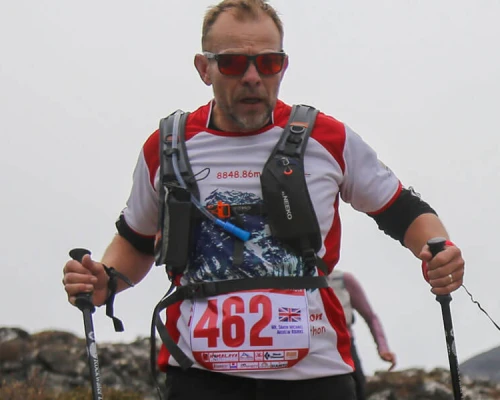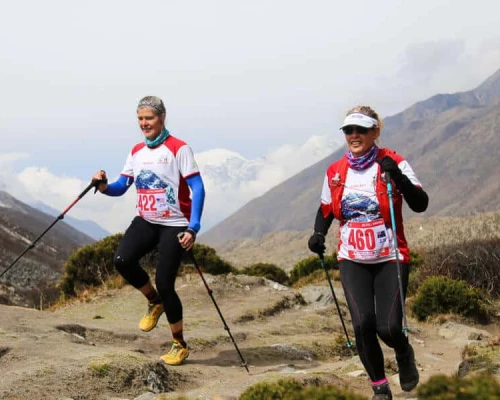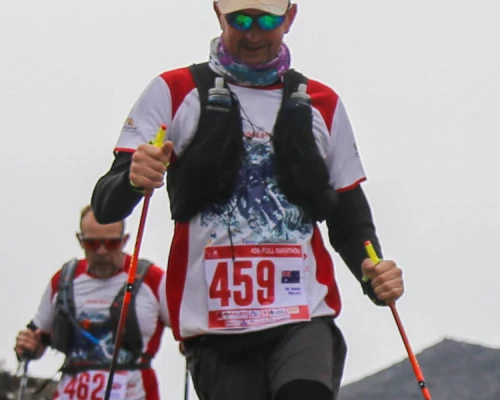Why is the Everest Marathon Event organized every year in Nepal?
The Everest Marathon is organized as a tribute to the historic and successful ascent of Mount Everest by Sir Edmund Hillary and Tenzing Norgay Sherpa 29th of May 1953. This remarkable achievement marked the first time in history that humans reached the summit of the world's highest peak. The marathon serves as a celebration of their pioneering spirit, courage, and determination, inspiring others to push their own limits and embrace the spirit of adventure.
Additionally, it helps to celebrate their extraordinary victory and keep their legacy alive for generations to come. So on the 29th of May every year travelers from around the world participate to celebrate this event and run from EBC to Namche Bazaar.
Is the Everest Marathon Trek Difficult?
Yes, the Everest Marathon trek is quite challenging. It involves high altitudes, long distances, and varied terrain, so it requires a good level of physical fitness and mental preparation. The marathon trek is certainly not a walk in the park, it's a physically demanding high-altitude extreme adventure. however, it is worth an effort for those who are up for the challenge and ready to test their limits.
What is the Weather like in May at Everest Base Camp for Marathon?
In May, the weather at Everest Base Camp is generally quite cool and pleasant. During the day, temperatures at lower elevations, like Namche Bazaar, might range from 10 to 20 degrees Celsius (50 to 68 degrees Fahrenheit). However, at higher altitudes, especially around Everest Base Camp, temperatures can drop significantly, often hovering around freezing or even below.
The weather is relatively dry in May, which makes it a popular time for treks and events like the Everest Marathon. The skies are usually clear, offering stunning views and temperatures appropriate for the marathon. However, it's essential to be prepared for varying conditions, as mountain weather can be unpredictable. Occasionally due to climate change, we are experiencing early pre-monsoon season that may sometimes be a hindrance to clear weather, views, marathons, and Lulka flights.
Do I need to be physically fit for the Everest Marathon Trek?
Absolutely YES. You need to be physically fit for the Everest Marathon. This marathon is an incredibly challenging event that takes place at high altitudes, and it involves running on rugged terrain. Without a good level of physical fitness, it would be very difficult or impossible to undertake something so demanding as the Everest Marathon.
Without sound fitness to participate in such events could potentially put your health at risk. It is an absolute must to prepare yourself through proper training and conditioning to ensure that you have the stamina and strength required to tackle this demanding adventure.
What happens if somebody gets sick or injured during Everest Marathon?
During the Everest Marathon, in the event of sickness or injury, there are measures in place to provide assistance and support. Volunteers equipped with walkie-talkies and other means of communication are stationed throughout the trail to promptly address any such situations.
Additionally, there is phone reception available in certain areas, allowing for communication with emergency services if needed. The organizers prioritize the safety and well-being of participants, and in cases of uncertainty or emergency, help will be readily available to ensure that any issues are addressed promptly and effectively.
Important Information
Complimentary Equipment:
During your pre-trip meeting in Kathmandu, we provide you with a complimentary waterproof Duffel Bag, buff (neck gaiter), 2 Toilet Rolls, a Map, and a Baseball Cap. The duffel bag will serve as a means to pack all your necessary trekking supplies for your upcoming adventure.
Your Daypack:
In addition to the duffel bag, it is essential that you have your own daypack with a waterproof cover. This daypack will be used to carry your daily necessities such as cash, important documents, water supplies or rehydration bladder, a camera, toiletries, sunscreen, a notebook, and extra clothing.
The equipment we Provide:
Besides the complimentary equipment, WITHOUT ANY EXTRA COST, we provide you with PrimaLoft wind stopper jackets, a Warm Down Sleeping Bag with liners, a Walking Stick if required, and Yak-Track (mini crampons where required). However, When trekking at altitudes above 4,000 m, it is crucial to have your personal lightweight down jacket and warm fleece Jackets or hoodies.
Drinking Water Supply:
In our commitment to environmental sustainability and responsible trekking practices, we wholeheartedly discourage the use of single-use mineral water bottles along the trekking route. To minimize plastic waste and protect the pristine Himalayan environment, our dedicated staff ensures a constant supply of safe, boiled drinking water throughout your journey. We kindly request that you carry reusable water bottles and rehydration bladder to stay well-hydrated. Together, we can make a positive impact on the delicate ecosystem of the Annapurna Circuit.
Assigning Porters:
To ensure your comfort and convenience, we assign one porter between two trekkers. The porter will be responsible for carrying the duffel bag throughout the entire trek. It is important to note that the weight of your duffel bag should not exceed 10/11 kg as the weight limitation for porters is 25/30kg max and if you are flying to any high mountain airports in Nepal your overall weight limitation including your duffle + daypack is only 15kg / 33 pounds.
Your Extra Luggage:
For your convenience, you can store all your extra luggage, and suitcases at the hotel SAFETY STORE in Kathmandu. This way, you can travel light and have peace of mind knowing that your belongings are safe and secure.
Tipping Tips:
Tipping is a gesture of appreciation, a heartfelt way to express gratitude for the incredible journey you've embarked upon and the dedication of the remarkable individuals who have been your guiding stars throughout your trek. The practice of tipping, at 10% of the trip cost, is a tradition that allows you to give back, acknowledging the extraordinary efforts of your guides, porters, and the entire team who make your adventure possible. It is a way to honor their dedication, hard work, and the stories they've shared around the campfire, deepening the bonds formed in the heart of the mountains.
Caution at the Airport on Arrival:
Upon arrival, we strongly advise against entrusting your bag to anyone other than our trusted office representatives. Unknown airport porters taking your luggage for a few seconds and claiming for TIPS is a very common incident at the airport. Our team is there to ensure that your belongings remain safe and that you can embark on your adventure with confidence. Your safety and peace of mind are our utmost priority.
We hope this information clarifies the important details regarding your trip. Should you have any further questions or concerns, please do not hesitate to reach out to us at [email protected]. We want to ensure that you have a safe and enjoyable trekking experience in Nepal. Packing List for Everest Base Camp Trekking:
Detail Information on Flying to Lukla from Different Airports
Nepal Aviation Authority (NAA) has recently introduced new rules regarding Lukla flights. These rules aim to enhance the safety and efficiency of air travel to and from the Lukla airport, which is known for its challenging terrain and weather conditions.
The choice of airport for accessing Lukla is primarily based on different seasons. Manthali is used as an alternative to Lukla during peak seasons when Lukla flights are often disrupted due to weather and congestion, while Kathmandu remains the preferred choice during the off-season for its convenience and more reliable flight schedules.
Trekkers and climbers need to be prepared for potential flight delays and cancellations regardless of the airport they use, as weather conditions in the Everest region can be unpredictable.
1. Lukla Airport (Tenzing-Hillary Airport):
- High Altitude and Short Runway: Lukla Airport is situated at a high altitude of approximately 2,845 meters (9,334 feet) and has one of the shortest commercial runways in the world, just 1,729 feet long. This combination of high altitude and a short runway makes it a challenging airport for both takeoff and landing.
- Weather Variability: The weather in the Everest region, especially around Lukla, is highly unpredictable, with frequent fog, cloud cover, and high winds. These conditions can lead to frequent flight delays and cancellations.
- Limited Infrastructure: Lukla Airport has limited infrastructure, including just one small terminal building and a single runway. This can result in congestion during peak trekking seasons when numerous trekkers and climbers are trying to get to Lukla.
2. Manthali Airport (Ramechhap Airport):
- Alternative During Peak Season: Manthali Airport, located in Ramechhap, is often used as an alternative to Lukla during the peak trekking seasons (spring and autumn). The advantage is that it is less congested, and flights are generally more reliable.
- Distance from Kathmandu: Manthali Airport is approximately a 4-5 hour drive from Kathmandu. Trekkers are transported by road to Manthali from Kathmandu, and then they take a relatively short flight to Lukla. This helps in alleviating some of the pressure on Lukla Airport.
- Reduced Weather Impact: The weather in Manthali is usually more stable than Lukla during peak seasons, making it a preferred alternative when flights from Kathmandu to Lukla are frequently disrupted.
3. Kathmandu Airport:
- Alternative During Off-Season: During the off-peak trekking seasons (summer and winter), flights to Lukla from Kathmandu are relatively more reliable due to better weather conditions. In this case, it's more practical to fly directly from Kathmandu to Lukla.
- Convenience: Flying from Kathmandu to Lukla is more convenient in terms of time and transportation costs during the off-season when the number of trekkers is significantly lower.
Weight Limitation while Flying to Lukla
The weight limitation for Lukla flights is typically quite strict due to the short runway and high altitude of Lukla Airport, which makes it challenging for aircraft to take off and land. The weight restrictions are in place to ensure the safety of the flight. The specific weight limitations is 15kg or 33 Pounds:
- Baggage Allowance: Passengers are usually allowed a specific weight limit for their checked baggage, typically between 10 kg to 15 kg (22 to 33 pounds) per person..
- Hand Luggage: In addition to checked baggage, passengers are typically allowed a small amount of hand luggage, which is usually limited to around 5 kg (11 pounds). This hand luggage should be small and fit under the seat in front of you.
- Combined Weight: So the total combined weight of the luggage is not to exceed over 15/16 kg / 33/35 pounds
- Excess Baggage: If you exceed the weight limitations, you may be required to pay extra fees for excess baggage or leave some items behind. The charges for excess baggage can vary with airlines you choose.
Traveling light is strongly recommended when flying to Lukla. Given the weight limitations and potential flight disruptions due to weather conditions, it's best to pack only the essentials and keep your baggage within the specified limits to avoid any inconveniences or additional costs.
Lukla Flight Delays And Cancellations
Flight delays and cancellations to and from Lukla Airport are not uncommon and are often due to a combination of factors related to the airport's unique location, weather conditions, and the limitations of the aircraft used for these flights.
1. Weather Conditions:
- Unpredictable Weather: Lukla Airport, is highly vulnerable to rapidly changing weather conditions. The airport's mountainous terrain means it's often shrouded in fog, cloud cover, and receives high winds, making flying conditions challenging.
- Low Visibility: Low visibility due to fog or cloud cover can lead to flight delays or cancellations, as pilots require clear visibility to navigate the treacherous mountainous terrain.
2. Limited Instrumentation:
- Lukla Airport lacks advanced navigation and landing systems. The absence of instrument landing systems and radar technology means flights often rely on visual flight rules (VFR), which require good weather conditions to operate safely.
3. Airport Congestion:
- During peak trekking seasons, Lukla Airport experiences congestion as numerous trekkers, climbers, and supplies try to access the region. The limited infrastructure and parking space can lead to delays.
4. Safety Considerations:
- Safety is a top priority for airlines operating in this region. If weather conditions are unfavorable or if there are safety concerns, airlines may choose to delay or cancel flights to ensure the well-being of passengers and crew.
5. Limited Window for Flights:
- Lukla flights typically operate in the early morning when the weather is relatively stable. This limited window means there's less flexibility to reschedule flights if conditions deteriorate.
6. Seasonal Variations:
- Flight disruptions can vary with the seasons. Peak trekking seasons (spring and autumn) are more susceptible to delays due to higher passenger volumes and less favorable weather patterns. Off-peak seasons (summer and winter) may see fewer disruptions.
Given these challenges, trekkers and travelers to the Everest region should be prepared for the possibility of flight delays and cancellations.









